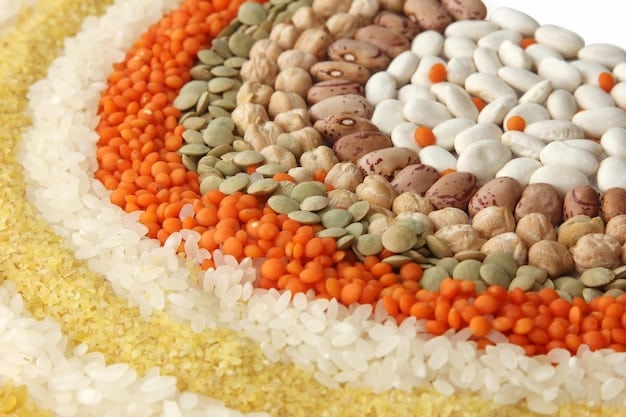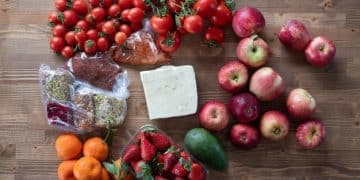Mediterranean Diet on a Budget: Delicious and Affordable Meal Plans for Under $50 a Week

The Mediterranean diet, celebrated for its health benefits, is surprisingly accessible on a budget, allowing individuals to enjoy its rich flavors and nutritional advantages for under $50 a week through strategic meal planning, smart grocery shopping, and creative use of affordable, staple ingredients like legumes, seasonal produce, and whole grains.
Embarking on a healthy eating journey often brings to mind hefty grocery bills and exotic ingredients. However, the notion that nutritious eating must be expensive is a common misconception, especially when considering the Mediterranean Diet on a Budget: Delicious and Affordable Meal Plans for Under $50 a Week. This dietary approach, renowned for its health benefits, is inherently frugal, emphasizing accessible, whole foods that won’t break the bank.
Mediterranean Diet Fundamentals: What It Is and Why It Works on a Budget
The Mediterranean diet isn’t just a meal plan; it’s a lifestyle inspired by the traditional eating habits of people in countries bordering the Mediterranean Sea. Rich in plant-based foods, healthy fats, and lean proteins, it consistently ranks among the healthiest diets globally. But beyond its health credentials, its core principles make it remarkably suitable for those aiming to eat well without overspending.
At its heart, the Mediterranean diet champions simplicity, seasonality, and the abundance of nature. It steers away from processed foods, sugary drinks, and excessive red meat, which are often the culprits behind inflated grocery bills. Instead, it promotes ingredients that are naturally inexpensive and widely available, embracing a philosophy of mindful consumption that aligns perfectly with a budget-friendly approach.
Core Principles and Affordable Staples
Understanding the fundamental components of this diet is the first step toward making it budget-friendly. It emphasizes a high intake of fruits, vegetables, whole grains, nuts, seeds, and legumes. Olive oil is the primary source of fat, and fish is consumed regularly, while poultry, eggs, and dairy are enjoyed in moderation. Red meat is eaten sparingly. This focus on staple ingredients naturally lends itself to cost-effective meal planning.
- Legumes: Dry beans, lentils, and chickpeas are incredibly versatile, packed with protein and fiber, and exceptionally cheap. They serve as excellent meat substitutes, stretching your budget further.
- Whole Grains: Options like brown rice, oats, whole-wheat pasta, and whole-grain bread are filling, nutritious, and economical. Buying in bulk can further reduce costs.
- Seasonal Produce: Prioritizing fruits and vegetables that are in season often means they are fresher, more flavorful, and significantly cheaper. Local farmers’ markets can be a treasure trove for affordable, seasonal finds.
- Olive Oil: While a good quality extra virgin olive oil might seem like an initial investment, its health benefits and versatility in cooking make it a cost-effective choice in the long run, replacing more expensive fats.
By focusing on these readily available and affordable ingredients, the Mediterranean diet becomes not just a healthy choice, but a financially savvy one. It’s about making smart choices at the grocery store and getting creative in the kitchen, proving that delicious, nourishing meals don’t require an exorbitant budget.
Strategic Shopping: Maximizing Your Budget at the Grocery Store
Achieving a Mediterranean diet for under $50 a week requires more than just knowing what to buy; it demands a strategic approach to shopping. Every decision, from where you shop to how you organize your list, plays a crucial role in keeping costs down. This segment delves into actionable strategies that make your grocery budget work harder for you.
The first step begins before you even leave your house: meal planning. When you know exactly what you’ll be cooking for the week, you can create a precise shopping list, minimizing impulse buys and food waste—two major culprits of budget overruns. Think about meals that share ingredients, allowing you to buy larger, more economical quantities of certain items.
Smart Shopping Habits for Savings
There’s an art to saving money at the grocery store without compromising on nutrition. It involves a combination of smart choices and disciplined habits.
- Shop Sales and Use Coupons: Always check weekly flyers and online deals for your local supermarkets. Building your meal plan around discounted items can lead to substantial savings. Digital coupons and store loyalty programs are also invaluable.
- Buy in Bulk (Wisely): Non-perishable Mediterranean staples like dried lentils, beans, whole grains, and nuts are often cheaper when purchased in larger quantities from bulk bins or warehouse clubs. Just ensure you have adequate storage.
- Prioritize Store Brands: For many pantry staples, store brand versions often offer comparable quality to national brands at a fraction of the cost. Taste tests sometimes even reveal they are indistinguishable.
- Frozen and Canned Produce: Don’t shy away from frozen fruits and vegetables. They are often picked at peak ripeness, preserving nutrients, and are generally cheaper than fresh, especially out of season. Canned beans, tomatoes, and certain fish are also excellent budget-friendly options, but opt for low-sodium whenever possible.

Another crucial tip is to avoid shopping on an empty stomach. When hungry, we’re more prone to making impulsive, often unhealthy and expensive, purchases. Stick to your list, and if time permits, compare prices between a couple of different stores. Sometimes, a short drive can yield significant savings on staple items.
By embracing these strategic shopping habits, you transform grocery shopping from a mundane chore into an empowering act of financial management. It’s about being informed, disciplined, and resourceful, ensuring that every dollar spent contributes to delicious, healthy, and budget-friendly Mediterranean meals.
Crafting Your Meal Plan: A Week of Affordable Mediterranean Delights (Under $50)
The true test of a budget-friendly diet lies in its practical application: can you actually create a week’s worth of diverse, satisfying meals for a modest sum? The answer, unequivocally, is yes, especially with the Mediterranean diet’s inherent strengths. This section will outline a sample meal plan that demonstrates how to stay under the $50 mark without sacrificing flavor or nutrition.
This sample plan emphasizes versatility, minimal waste, and the clever repurposing of ingredients. It assumes you already have basic pantry staples like salt, pepper, common spices, and cooking oil (ideally olive oil). The focus is on maximizing the potential of humble, affordable ingredients to create vibrant and fulfilling Mediterranean dishes.
Sample 7-Day Meal Plan
This plan aims for efficiency, often using leftover components or cooking larger batches of grains/legumes to be incorporated into multiple meals. The costs are estimates and can vary based on region, store sales, and specific brand choices.
- Monday
- Breakfast: Oatmeal with Berries (frozen) and a sprinkle of nuts (bought in bulk).
- Lunch: Large Mixed Salad with Chickpeas, Cucumber, Tomatoes, and a simple Vinaigrette.
- Dinner: Lentil Soup with Whole-Wheat Bread.
- Tuesday
- Breakfast: Hard-boiled Eggs (2) with a slice of whole-wheat bread.
- Lunch: Leftover Lentil Soup.
- Dinner: Whole-Wheat Pasta with Marinara Sauce (canned tomatoes) and Canned Tuna.
- Wednesday
- Breakfast: Greek Yogurt (plain, larger tub for cost-effectiveness) with a drizzle of honey and a few more berries.
- Lunch: Tuna Salad on whole-wheat bread (using leftover tuna from dinner).
- Dinner: Bean Burritos (whole-wheat tortillas, canned black beans, salsa, onions, peppers – all cheap).
- Thursday
- Breakfast: Oatmeal with a banana.
- Lunch: Leftover Bean Burrito filling as a salad topper.
- Dinner: Roasted Chicken Thighs (affordable cut) with Roasted Seasonal Vegetables (carrots, potatoes, onions).
- Friday
- Breakfast: Hard-boiled Eggs (2) and an orange.
- Lunch: Leftover Roasted Vegetables and Chicken (cold or reheated).
- Dinner: Mediterranean Bowl: Brown Rice, Chickpeas, Cucumber, Tomatoes, Olives (canned/jarred), Feta (small amount for flavor).
- Saturday
- Breakfast: Plain Greek Yogurt with a handful of nuts.
- Lunch: Leftover Mediterranean Bowl.
- Dinner: Vegetable Frittata (eggs, onions, peppers, spinach) with a side salad.
- Sunday
- Breakfast: Whole-wheat toast with a mashed avocado (if affordable/on sale).
- Lunch: Sandwich with hummus, cucumber, and bell peppers on whole-wheat bread.
- Dinner: Large batch of Minestrone Soup (vegetable broth, pasta, various canned veggies, beans).
This plan highlights how simple modifications and strategic ingredient use keep costs low. For instance, chicken thighs are cheaper than breasts, and canned fish like tuna or sardines offer excellent protein without the high cost of fresh fish. Embracing fruits and vegetables in season is critical, as is making use of legumes as primary protein sources. By following a similar structure, even with variations based on personal preferences and local pricing, it’s entirely feasible to maintain this healthy diet on a strict budget.
Key Ingredients Breakdown: Making Every Dollar Count
Successfully adhering to a Mediterranean diet on a budget, specifically under $50 a week, hinges on a deep understanding of which ingredients offer the best value for money regarding nutrition, versatility, and cost-effectiveness. This section breaks down the essential components that form the backbone of affordable Mediterranean cooking, highlighting their benefits and smart purchasing tips.
It’s not just about buying cheap items; it’s about investing in ingredients that provide maximum culinary flexibility and nutritional density. Think of staples that can be transformed into multiple dishes throughout the week, minimizing waste and maximizing flavor.
The Powerhouse Pantry Staples
Certain items consistently prove to be the unsung heroes of a budget-friendly Mediterranean kitchen. Stocking up on these provides a solid foundation for countless meals.
- Dried Legumes (Lentils, Chickpeas, Beans): Unbeatable for protein, fiber, and iron. A pound of dried lentils can yield several meals for just a dollar or two. They are fantastic in soups, stews, salads, and even dips like hummus.
- Whole Grains (Brown Rice, Oats, Whole-Wheat Pasta): These provide complex carbohydrates for sustained energy. Buying larger bags of rice and oats is highly economical. Whole-wheat pasta offers a healthier, fiber-rich alternative to refined versions at a similar price.
- Canned Tomatoes (Diced, Crushed, Paste): The basis for countless sauces, stews, and soups. They are affordable year-round and packed with flavor. Look for sales to stock up.
- Olive Oil: While a larger upfront cost, a good bottle of extra virgin olive oil lasts a long time and is fundamental to the diet’s healthy fat intake. Purchase larger containers for better per-ounce pricing.
- Onions, Garlic, and Potatoes: These workhorse vegetables are incredibly cheap, long-lasting, and form the aromatic base for almost any savory dish, adding depth of flavor without extra cost.
- Seasonal Fruits and Vegetables: This is where flexibility comes in. Focus on what’s abundant and cheap in your area. Root vegetables, sturdy greens, and apples or bananas are often more affordable and keep well.
When selecting these ingredients, consider their shelf life and how they can be stored. For instance, dried legumes last indefinitely, while fresh produce requires more immediate planning. Buying in different forms (fresh, frozen, canned) also plays a role in budget management and convenience. For example, frozen spinach is often cheaper than fresh and equally nutritious for cooking.
By prioritizing these resourceful ingredients and learning to combine them creatively, you unlock the full potential of the Mediterranean diet on a budget. It transforms simple components into a diverse array of healthy and delicious meals, proving that culinary richness doesn’t require a large bank account. 
Creative Cooking & Meal Prep: Making Your Food Work Harder
Eating well on a strict budget—especially for under $50 a week—is less about deprivation and more about ingenuity. The Mediterranean diet lends itself beautifully to creative cooking and strategic meal preparation, allowing you to stretch ingredients, minimize waste, and ensure healthy meals are always within reach. This section explores practical tips for culinary creativity that don’t cost extra.
Meal prepping is not just for fitness enthusiasts; it’s a powerful tool for budget management. By dedicating a few hours each week to chopping vegetables, cooking grains, and preparing sauces, you streamline your cooking process, reduce the temptation for expensive last-minute takeaways, and make the most of every ingredient bought.
Smart Strategies for the Kitchen
Maximizing your food budget involves being smart about how you prepare and store your meals. These tips embrace the Mediterranean philosophy of resourcefulness.
- Batch Cooking: Cook larger quantities of staple ingredients like brown rice, quinoa, lentils, or roasted vegetables. These can then be incorporated into different meals throughout the week (e.g., roasted veggies for a side dish one night, then added to a frittata or salad another day).
- Transforming Leftovers: Don’t just reheat; rethink. Leftover roasted chicken can become part of a Mediterranean-inspired sandwich or salad. Extra lentil soup can be blended into a thicker dip or sauce. Creative repurposing stretches your food currency.
- Homemade Basics: Making your own salad dressings (simple vinaigrettes with olive oil, vinegar, and herbs), hummus, or vegetable broth from scraps saves money and allows you to control ingredients.
- Embrace “One-Pot” or “Sheet Pan” Meals: These cooking methods are not only convenient but also minimize cleanup and often involve simple, affordable ingredients like vegetables, beans, and lean proteins, all roasted together for maximum flavor.
Freezing prepared meals or components is another excellent strategy. Cooked beans, portions of soup, or even pre-chopped vegetables can be frozen for later use, preventing spoilage and ensuring you always have healthy options available. This reduces food waste, which directly impacts your grocery budget.
Furthermore, learning basic cooking techniques like how to properly sauté, roast, or simmer can elevate simple ingredients. A well-seasoned, perfectly roasted batch of vegetables can be just as satisfying as a complex dish, and often far more economical. By embracing these creative and preparatory practices, the Mediterranean diet becomes an even more accessible and enjoyable journey, proving that healthy eating on a budget is not only possible but can lead to delightful culinary discoveries.
Overcoming Obstacles: Common Challenges and Solutions to Budget Eating
Adopting any new dietary approach, especially one with a strict budget, comes with its own set of hurdles. While the Mediterranean diet is inherently budget-friendly, challenges can arise, from lack of time for cooking to resistance to new flavors. This section addresses common obstacles and offers practical, actionable solutions to ensure your journey to a healthy, affordable Mediterranean lifestyle is smooth and sustainable.
It’s important to acknowledge that perfection isn’t the goal. Small, consistent steps and a flexible mindset are key to long-term success. Understanding potential pitfalls allows for proactive strategies to overcome them.
Addressing Common Hurdles
Many factors can derail budget eating plans, but most have straightforward solutions.
- Time Constraints:
- Challenge: Busy schedules leave little time for cooking.
- Solution: Embrace meal prep. Dedicate a couple of hours on a quieter day to chop vegetables, cook grains, and prepare large batches of staples like soups or bean dishes. Focus on simple recipes with minimal ingredients and cooking steps.
- Lack of Culinary Skills/Confidence:
- Challenge: Unsure how to prepare healthy, affordable meals.
- Solution: Start simple. Focus on basic recipes like lentil soup, roasted vegetables, or simple pasta dishes. Utilize online resources for beginner-friendly Mediterranean recipes. The more you cook, the more confident you’ll become.
- Picky Eaters (Including Yourself!):
- Challenge: Aversion to certain “healthy” ingredients.
- Solution: Introduce new foods gradually. Disguise vegetables in sauces or smoothies. Experiment with different cooking methods or spices to find appealing flavors. Remember, the Mediterranean diet is diverse; there’s something for everyone.
- Managing Cravings and Temptations:
- Challenge: Desire for expensive processed foods or takeaways.
- Solution: Keep healthy, budget-friendly snacks on hand (fruits, nuts, roasted chickpeas). Plan your meals meticulously to avoid last-minute hunger-induced impulse buys. Allow for occasional, planned indulgences that fit your budget, rather than feeling deprived.
Another common issue is food waste. Even with the best intentions, forgotten produce or unfinished leftovers can quickly add up. Combat this by regularly reviewing your fridge, labeling and dating leftovers, and planning meals that specifically use up expiring ingredients. Portion control is also important; cook only what you need, or plan to freeze excess portions.
Navigating the world of budget-friendly eating while adhering to the Mediterranean diet requires patience and adaptability. By anticipating challenges and implementing these practical solutions, you can maintain a delicious, nutritious, and cost-effective eating plan, proving that a healthy lifestyle is well within reach, no matter your budget.
Long-Term Sustainability: Beyond the $50 Weekly Budget
While the goal of achieving a Mediterranean diet for under $50 a week is a significant victory, the ultimate aim is long-term sustainability. This isn’t just a temporary challenge; it’s about building healthy, economical eating habits that can last a lifetime. This section looks beyond the initial budget constraints, focusing on how these principles can be integrated into a sustainable, consistent lifestyle.
The lessons learned from eating on a strict budget—resourcefulness, mindful consumption, and efficient planning—are invaluable. They lay the groundwork for a dietary approach that is not only healthy and affordable but also environmentally conscious and personally empowering.
Building Lasting Habits
Sustaining a budget-friendly Mediterranean diet involves evolving from simply hitting a number to genuinely embracing the philosophy behind it.
- Flexibility and Adaptation: Your budget or preferences might change. Learn to adapt. If a certain vegetable becomes too expensive, swap it for a cheaper, seasonal alternative. The Mediterranean diet is about principles, not rigid rules.
- Continuous Learning: Keep exploring new recipes and cooking techniques that highlight affordable ingredients. Discover new ways to use staples like lentils or chickpeas. Culinary boredom can lead to costly cravings.
- Mindful Eating: Pay attention to your body’s hunger and fullness cues. This helps prevent overeating, which can lead to unnecessary food purchases and waste. Savoring your meals also enhances the dining experience, making healthy food more enjoyable.
- Community and Support: Share your journey with friends or family. Exchange recipes, share bulk purchases, or even cook together. A supportive environment can make healthy eating more enjoyable and sustainable.
- Grow Your Own (If Possible): Even a small herb garden or a few tomato plants can provide fresh, organic produce, cutting down on grocery bills and offering immense satisfaction.
The discipline cultivated from adhering to a budget for your Mediterranean diet often translates into other areas of financial prudence. It teaches you to value what you buy, to plan ahead, and to make smart decisions. This ripple effect contributes to overall well-being, reinforcing the idea that healthy living is holistic.
Ultimately, a sustainable budget-friendly Mediterranean diet is about creating a symbiotic relationship with your food and your finances. It’s about recognizing that eating well doesn’t have to be a luxury; it can be an accessible, enjoyable, and enduring aspect of a healthy and fulfilling life, long after the initial $50 weekly challenge has been met and mastered.
| Key Point | Brief Description |
|---|---|
| 🍽️ Meal Planning | Essential for avoiding waste and impulse buys, maximizing your budget. |
| 🛒 Smart Shopping | Focus on sales, bulk buys, store brands, and seasonal produce to save significantly. |
| 💡 Core Ingredients | Prioritize legumes, whole grains, canned tomatoes, and seasonal produce for value and nutrition. |
| 🧑🍳 Creative Cooking | Batch cook, repurpose leftovers, and make homemade basics to stretch your food further. |
Frequently Asked Questions
▼
Yes, the Mediterranean diet can be highly effective for weight loss, even on a tight budget. Its emphasis on whole, unprocessed foods like vegetables, fruits, whole grains, and lean proteins promotes satiety and reduces calorie intake naturally. By cutting out expensive processed snacks and sugary drinks, you not only save money but also support your weight loss goals through nutrient-dense, flavorful meals.
▼
The most budget-friendly protein sources in the Mediterranean diet are legumes (dried lentils, chickpeas, and beans), eggs, and canned fish like tuna and sardines. These options are highly nutritious, versatile, and significantly cheaper than fresh meat or fish. Incorporating these regularly into your meal plan will help you meet your protein needs without exceeding your $50 weekly budget.
▼
Absolutely. While fresh fish can be expensive, the Mediterranean diet also embraces more affordable options. Canned tuna, sardines, and mackerel are excellent sources of omega-3s and protein. Look for frozen fish fillets, which are often cheaper when purchased in bulk. Prioritize smaller, sustainable fish varieties that are less expensive per pound. These choices make fish a regular, budget-friendly part of your diet.
▼
Flavor comes from smart seasoning, not just expensive ingredients. Rely on fresh or dried herbs (oregano, basil, thyme, rosemary), garlic, onions, and lemon juice. Toasted spices (cumin, paprika, coriander) add deep flavor without cost. Roasting vegetables brings out their natural sweetness, and a dash of good quality olive oil can transform a simple dish. Homemade dressings and marinades are also key to boosting flavor affordably.
▼
Proper storage is crucial for budget eating. Store dried goods like legumes and grains in airtight containers. Keep fresh produce sorted and in appropriate areas (fridge vs. counter), using crisper drawers optimally. Freeze excess portions of cooked meals, bread, or perishable produce like berries. Labeling and dating items helps prevent spoilage, ensuring you use everything you buy and stretch your budget further.
Conclusion
The journey to adopting the Mediterranean Diet on a Budget: Delicious and Affordable Meal Plans for Under $50 a Week is not merely about economizing; it’s about embracing a lifestyle that champions health, flavor, and financial prudence. By focusing on whole, unprocessed foods, strategic shopping, and creative culinary practices, it’s entirely feasible to enjoy the myriad benefits of this renowned diet without compromising your financial well-being. This approach proves that nutritious eating is accessible to everyone, transforming perceived limitations into opportunities for culinary discovery and a healthier future.





